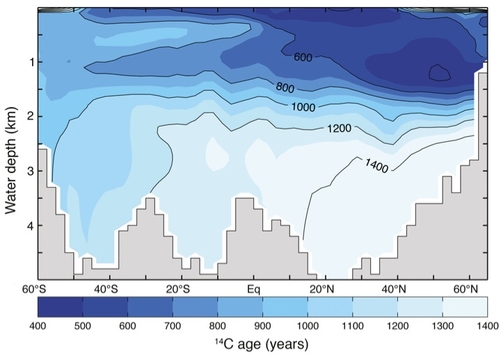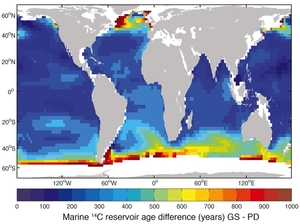Three-dimensional radiocarbon modeling: A tool to assess the last glacial ocean circulation and radiocarbon chronologies
At the Last Glacial Maximum (LGM), the overturning circulation of the ocean was probably quite different from today. The changes are still debated, as the current generation of coupled climate models arrive at contradictory results (e.g., Otto-Bliesner et al., 2007), and paleoceanographers face the problem of extracting robust and unambiguous information from proxy data.
In an attempt to reconcile observations with modeling, we simulated the distribution of marine radiocarbon (14C) at the LGM, using a three-dimensional ocean general circulation model connected with an atmospheric radiocarbon reservoir (Butzin et al., 2005). The ocean model has an effective horizontal resolution of 3.5°, with a vertical resolution of 22 depth levels, and it is forced with atmospheric fields, which were derived in previous glacial climate simulations (as described by Prange et al., 2004). In a series of sensitivity studies with constant boundary conditions, we explored the influence of sea surface temperatures, sea ice extent, wind stress, and Antarctic sea ice formation on the glacial 14C distribution and on the meridional overturning circulation (MOC).
Our simulations reveal a crucial influence of the background climate conditions on the results. The best agreement of modeled 14C distributions with glacial 14C observations is for a model run with significant MOC changes in the Atlantic, where the North Atlantic Deep Water (NADW) shallows to a depth above about 2 km and weakens by about 40% compared to the present day. Conversely, Antarctic Bottom Water flow intensifies and compensates for the weakened NADW transport into the South Atlantic. As a consequence, the modeled abyssal glacial Atlantic is depleted in 14C (Fig. 1), very cold and very saline. These results are in line with proxy data evidence (see Lynch-Stieglitz et al., 2007, for a review).
Figure 1: Radiocarbon age in the western Atlantic (along the GEOSECS track) according to simulations for the Last Glacial Maximum (Butzin et al., 2005).
Radiocarbon concentrations in environmental samples are frequently quoted in the form of ages relative to atmospheric 14C values. Applying the law of radioactive decay, high 14C concentrations translate into low 14C ages, and vice versa. Radiocarbon concentrations of the present-day surface ocean correspond to an apparent marine reservoir 14C age (MRA) of about 400 yr in the global mean, and range from about 300 yr in the subtropics to 1000 yr at high latitudes (e.g., Key et al., 2004). Our simulations indicate generally higher MRAs for the LGM (Fig. 2). This reflects slower uptake of 14C by the glacial ocean, which is predominantly due to the reduced partial pressure of atmospheric CO2 and weakened MOC at the LGM. The spatial and temporal variability of MRAs is a critical factor in 14C dating. Beyond the tree ring record (i.e., before ca. 12.4 cal kyr BP), atmospheric chronologies for 14C dating rely to a large extent on cross-dated marine archives such as laminated sediments or corals. Although there is observational evidence for considerable MRA changes during the last deglaciation (e.g., see Cao et al., 2007, and references therein), most 14C chronologies have not included this effect but assume time-invariant MRA values.
For this reason, we devised a self-consistent iteration scheme in which existing radiocarbon chronologies for the last deglaciation can be readjusted by transient, three-dimensional simulations of marine and atmospheric Δ14C (Butzin et al., 2012). The idea is to infer atmospheric Δ14C from marine reconstructions by back and forth model calculations. The iteration scheme starts with a prescribed atmospheric Δ14C chronology (derived from marine data assuming a certain inverse MRA correction), and uses an ocean model to diagnose the corresponding evolution of marine Δ14C. If there are differences between model results and reconstructions, the atmospheric chronology has to be adjusted by applying a modified MRA correction, and the ocean model is rerun using this new atmospheric 14C input curve. The procedure is repeated until model results and reconstructions converge, which implies that atmospheric Δ14C values and MRAs are consistent with marine reconstructions.
Figure 2: Marine reservoir age difference between the glacial (GS) and the present-day (PD) ocean, based on model calculations (Butzin et al., 2005).
To estimate the uncertainties associated with the intensity of ocean ventilation during the last deglaciation, we examined the effect of different climatic background states (ranging from a Heinrich meltwater event-type state with substantially reduced MOC to a present-day state with strong MOC), and thus obtained upper and lower bounds for the deglacial MRA evolution. As an example, we considered a 14C chronology from the Caribbean, which originally assumed a time-invariant MRA value of 420 yr (Hughen et al. 2006; see Fig. 3). Our simulations started from steady-state conditions at 25 cal kyr BP assuming atmospheric Δ14C = 530‰. We focused on the period 20–14 cal kyr BP, as the first millennia of the simulations may be biased by the model’s adaptation to the transient 14C input history. The readjustment points to MRAs of 100–850 yr in the Cariaco Basin during the last deglaciation. Correspondingly, the variability of re-adjusted atmospheric Δ14C increases by –50 to +100‰, and increases the mysterious drop of atmospheric concentrations between 17.5 and 14.5 cal kyr BP discussed by Broecker and Barker (2007).
Our readjustment approach is complementary to statistical methods devised for the estimation of 14C chronologies (such as devised by Buck and Blackwell, 2004). Uncertainties of this approach due to potential model deficiencies could be narrowed down by ensemble and intercomparison runs.
(PAGES news, Vol. 16, No. 2. April 2008)
Figure 3: Readjustment of an atmospheric 14C chronology (Hughen et al., 2006, originally assuming a time-invariant marine reservoir age correction of 420 yr) by self-consistent modeling. Different climatic forcing scenarios yield upper and lower bounds spanning the uncertainty range of the readjustment approach (Butzin et al., 2008).
References
- Butzin, M., Prange, M. and Lohmann, G., 2005: Radiocarbon simulations for the glacial ocean: The effects of wind stress, Southern Ocean sea ice and Heinrich events, Earth and Planetary Science Letters, 235: 45–61.
- Butzin, M., Prange, M., and G. Lohmann, 2012: Readjustment of glacial radiocarbon chronologies by self-consistent three-dimensional ocean circulation modeling. Earth and Planetary Science Letters 317–318, 177–184. (link) doi:10.1016/j.epsl.2011.11.046
- Cao, L., Fairbanks, R.G., Mortlock, R.A. and Risk, M.J., 2007: Radiocarbon reservoir age of high latitude North Atlantic surface water during the last deglacial, Quaternary Science Reviews, 26: 732-742.
- Hughen, K.A., Southon, J., Lehman, S., Bertrand, C. and Turnbull, J, 2006: Marine-derived 14C calibration and activity record for the past 50,000 years updated from the Cariaco Basin, Quaternary Science Reviews, 25: 3216–3227.
- Lohmann, G., M. Butzin, N. Eissner, X. Shi, C. Stepanek, 2020: Abrupt climate and weather changes across timescales. Paleoceanography and Paleoclimatology 35 (9), e2019PA003782, DOI:10.1029/2019PA003782, Special Section AGU Grand Challenges in the Earth and Space Sciences. (link to PANGAEA) (link to AWI-ESM) (news) (pdf) (link)
- Lynch-Stieglitz, J., et al., 2007: Atlantic Meridional Overturning Circulation During the Last Glacial Maximum; Science, 316: 66–69.
- Otto-Bliesner, B.L., Hewitt, C.D., Marchitto, T.M., Brady, E., Abe-Ouchi, A., Crucifix, M. Murakami, S. and Weber, S.L., 2007: Last Glacial Maximum ocean thermohaline circulation: PMIP2 model intercomparison and data constraints, Geophysical Research Letters, 34: L12706.


